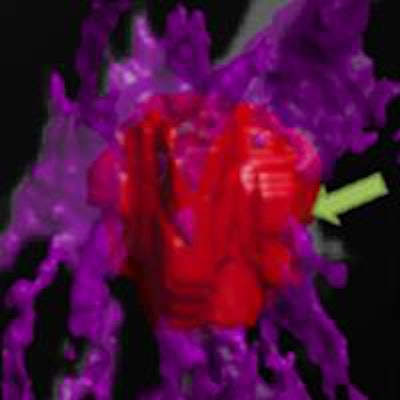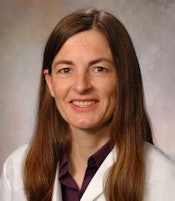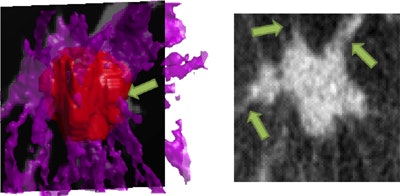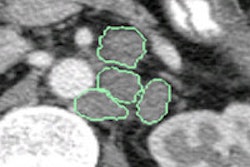
University of Chicago researchers significantly improved the performance of their computer-aided detection (CAD) algorithm for breast CT studies by having it detect lesion spiculation automatically, according to a new study.
The researchers examined spiculation detection along with other textural- and morphology-based features for identifying biopsy-proven malignancies. They believe their findings could help breast CT develop into a routinely used modality for both screening and diagnosis.
 Ingrid Reiser, PhD, from the University of Chicago.
Ingrid Reiser, PhD, from the University of Chicago."Potential advantages [of breast CT] include the full resolution of the 3D breast structure, and tissue overlap is virtually eliminated," said Ingrid Reiser, PhD, in a presentation at the recent RSNA 2014 meeting. "Dedicated breast CT spiculation is an important indicator of malignancy."
Spiculation can often be seen unaided on mammography, but the task becomes more complicated with dedicated breast CT. The large volume of breast CT datasets is challenging, and each case takes much longer to interpret than mammography, Reiser explained. Typically, each CT dataset contains hundreds of slices, compared with standard two-view mammography.
To address this issue, the University of Chicago researchers are developing CAD and diagnostic techniques to help interpret such large image volumes, said Reiser, an assistant professor of radiology. She presented the work on behalf of lead investigator Hsien-Chi Kuo, PhD.
The 3D spiculation feature was added to improve CAD's classification performance. The classification feature builds upon previous work by Kuo et al, which is now incorporated into the process, Reiser said.
Use of the spiculation feature begins with manual identification of lesion centers. Volume-of-interest extraction with image smoothing is then applied. The tissue segmentation identifies whether the tissue is fibroglandular or adipose.
"Then we look for contact points between the fibroglandular tissue and lesion segmentation," Reiser said. "The spiculation index is the count of connected contact regions between the lesion segmentation and the tissue map. We hope that benign lesions have fewer connected regions."
 Segmentation of spiculated breast lesion image. Red (left) represents the segmented lesion (expanded for illustration), while purple (anything that appears white in the CT scan) represents tissue classified as fibroglandular. When there's a spiculation (gray at right, or appearing as purple tissue at left), it "pierces" the red surface because it is connected to the lesion. The spiculation index counts how often the red surface is pierced. Images courtesy of Ingrid Reiser, PhD.
Segmentation of spiculated breast lesion image. Red (left) represents the segmented lesion (expanded for illustration), while purple (anything that appears white in the CT scan) represents tissue classified as fibroglandular. When there's a spiculation (gray at right, or appearing as purple tissue at left), it "pierces" the red surface because it is connected to the lesion. The spiculation index counts how often the red surface is pierced. Images courtesy of Ingrid Reiser, PhD.The researchers tested the feature on a database that included 129 masses -- 49 benign and 80 malignant -- in breast CT cases acquired at the University of California, Davis.
Evaluating the spiculation index (SI) across the database, the researchers found that SI was higher for malignant lesions (6.96 ± 3.93) than benign lesions (4.83 ± 3.34). The difference was statistically significant (p = 0.02).
Then came the feature analysis process, which included 53 textural and morphologic features in all. The study team employed stepwise feature selection with a leave-one-out loop to assess which features were more important. Receiver operator characteristics (ROC) analysis was used to distinguish malignant from benign lesions.
The area under the ROC curve for CAD improved from 0.81 without the spiculation feature to 0.85 with the feature in the task of breast mass classification (p < 0.001), the researchers found.
The study had a few limitations, including the moderate size of the database, and the fact that even though a leave-one-out evaluation method was used, the spiculation feature was developed and tested on the same dataset. More research is needed to address the robustness of the new feature on unknown cases -- and across different breast CT scanners and parameters.
"Our proposed 3D spiculation feature was able to significantly improve the performance of breast mass classification on dedicated breast CT," Reiser concluded.




















